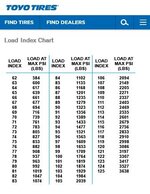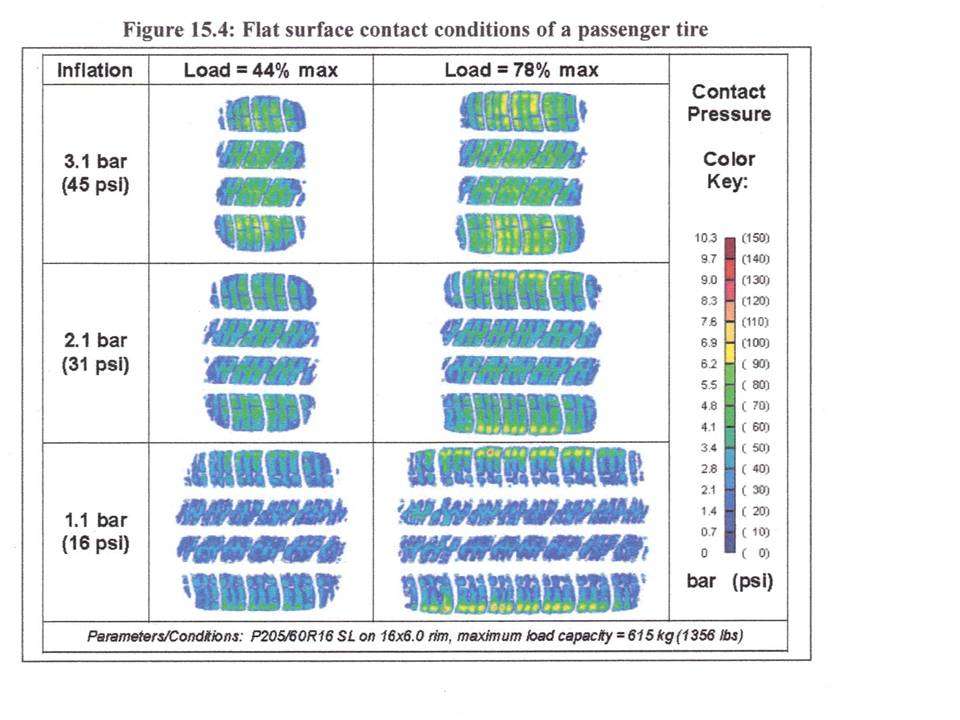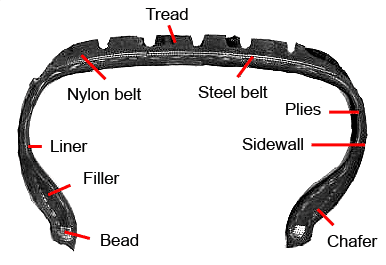CapriRacer
Member
- :
- Ford Capri Mark1
yrwei52,
First, you are going to find - if you haven't already - that the tire industry is chock full of imprecision, sloppiness, and complexity. This discussion deals with some of that.
Second, I hope you realize that when you use the term *P-Metric*, you are referring to the load table for Passenger Car tires as published by the US tire standardizing organization - The Tire and Rim Association (TRA, for short). It's called that because it uses the letter *P* in front of the numbers to designate that the tire is designed using that standard.
The Europeans have a slightly different system. Their standardizing organization is the European Tyre and Rim Technical Organization - commonly referred to as ETRTO. Passenger Car tires designed to that standard do NOT have a letter in front of the numbers. This is sometimes referred to as Eurometric - although I don't think this is in any way official like *P-metric* is.
The Japanese use JATMA - Japanese Automobile Tire Manufacturers Association - as their standardizing organization - and they have a third system.
All 3 of these systems result in very similar results - close enough that, for practical purposes, they are the same. Put another way, the company I used to work for used the same materials regardless of which system they were designing to - so the tires would be otherwise identical except for how the tire size was expressed.
One of the quirky things about these standards is that once they are published, they do NOT change. That is, the relationship between inflation pressure and load carrying capacity is based on a formula and a given set of tire dimensions (which are specified in the standard) and will always result in the same table. One way to look at this is that this table represents the Physics of how tires work.
The P-metric table was first published in the early 1970's, and the table has not changed - except to say that new tire sizes are constantly being added to the published list and obsolete sizes are being removed. If any of those sizes first published survived to the present day, the loads and inflation pressures would be identical - and I assume that there are sizes that survive, but my yearbooks only go back to 1989.
There has been a reference to a change that took place in 1998. In 1996, a new note appeared in the TRA yearbook. It stated it was permissible to use 44 and 51 psi as a max pressure - along with some calculations about the affect speed has on load carrying capacity. That note appears in the latest yearbook unchanged from 1996.
Some background info: When the US Federal government first started regulating tires (about 1968) they had a regulation that said - more or less - that the sidewall had to state the maximum load and pressure. Notice that it doesn't say max pressure or the pressure that corresponds to the max load. It's vague. At the time, the common way of expressing the max load situation was: Max Load XXXX at YY pressure. Please note that this way of expressing things doesn't say what the max usage pressure is - and even back then it was allowable to use more than pressure that stated on the sidewall.
But the Europeans were using speed ratings and the test was conducted at 35 psi for S rated tires, 44 psi for H rated tires, and 51 psi for V and higher rated tires. The note that TRA added was to address this. What should have happened is that every tire manufacturer should have changed to: Max Load XXXX, Max pressure YY. Because of the old way of expressing things, that is not what happened - and the result is this confusing mess we have now. Even Tire Rack thinks that every tire states a max pressure, but some of them don't!!
To add to this confusion, BMW and VW both had vehicle tire placards that had different inflation pressures depending on the situation. The current form of the vehicle tire placard (required as of 2008) does not allow this. A single pressure is specified.
As the photo above of a 2001 VW vehicle tire placard says, there is a matrix where you have: below 100 mph and above 100 mph AND half load and max load. Note that the tire would likely say a max pressure of 44 (or 51) psi, because it is an H speed rated tire. (Please note that a new VW's tire placard would not look like this.)
Note also that the below 100 mph/half load pressures are reasonable - as are the above 100 mph/half load pressures - and certainly, the above 100 mph/max load pressures could be the result of the speed. The only thing that doesn't quite fit is the rear pressure below 100 mph - 41 psi. Note that this tire is NOT an Extra Load tire, and the max pressure listed on the sidewall would NOT be 41 psi. The only explanation I have is that sometimes vehicle manufacturers will specify pressures above 35 psi for Standard Load tires for handling reasons.
OK, now that I have explained that, can I provide documentation to back it up?
Toyo Tires: Guidelines for the Application of Load and Inflation Tables
This directly addresses what you tried to point out about the Toyo A23 225/55R19 99V tire. On page 20, the max load of 1709# corresponds to 36 psi - not 51 psi.
First, you are going to find - if you haven't already - that the tire industry is chock full of imprecision, sloppiness, and complexity. This discussion deals with some of that.
Second, I hope you realize that when you use the term *P-Metric*, you are referring to the load table for Passenger Car tires as published by the US tire standardizing organization - The Tire and Rim Association (TRA, for short). It's called that because it uses the letter *P* in front of the numbers to designate that the tire is designed using that standard.
The Europeans have a slightly different system. Their standardizing organization is the European Tyre and Rim Technical Organization - commonly referred to as ETRTO. Passenger Car tires designed to that standard do NOT have a letter in front of the numbers. This is sometimes referred to as Eurometric - although I don't think this is in any way official like *P-metric* is.
The Japanese use JATMA - Japanese Automobile Tire Manufacturers Association - as their standardizing organization - and they have a third system.
All 3 of these systems result in very similar results - close enough that, for practical purposes, they are the same. Put another way, the company I used to work for used the same materials regardless of which system they were designing to - so the tires would be otherwise identical except for how the tire size was expressed.
One of the quirky things about these standards is that once they are published, they do NOT change. That is, the relationship between inflation pressure and load carrying capacity is based on a formula and a given set of tire dimensions (which are specified in the standard) and will always result in the same table. One way to look at this is that this table represents the Physics of how tires work.
The P-metric table was first published in the early 1970's, and the table has not changed - except to say that new tire sizes are constantly being added to the published list and obsolete sizes are being removed. If any of those sizes first published survived to the present day, the loads and inflation pressures would be identical - and I assume that there are sizes that survive, but my yearbooks only go back to 1989.
There has been a reference to a change that took place in 1998. In 1996, a new note appeared in the TRA yearbook. It stated it was permissible to use 44 and 51 psi as a max pressure - along with some calculations about the affect speed has on load carrying capacity. That note appears in the latest yearbook unchanged from 1996.
Some background info: When the US Federal government first started regulating tires (about 1968) they had a regulation that said - more or less - that the sidewall had to state the maximum load and pressure. Notice that it doesn't say max pressure or the pressure that corresponds to the max load. It's vague. At the time, the common way of expressing the max load situation was: Max Load XXXX at YY pressure. Please note that this way of expressing things doesn't say what the max usage pressure is - and even back then it was allowable to use more than pressure that stated on the sidewall.
But the Europeans were using speed ratings and the test was conducted at 35 psi for S rated tires, 44 psi for H rated tires, and 51 psi for V and higher rated tires. The note that TRA added was to address this. What should have happened is that every tire manufacturer should have changed to: Max Load XXXX, Max pressure YY. Because of the old way of expressing things, that is not what happened - and the result is this confusing mess we have now. Even Tire Rack thinks that every tire states a max pressure, but some of them don't!!
To add to this confusion, BMW and VW both had vehicle tire placards that had different inflation pressures depending on the situation. The current form of the vehicle tire placard (required as of 2008) does not allow this. A single pressure is specified.
As the photo above of a 2001 VW vehicle tire placard says, there is a matrix where you have: below 100 mph and above 100 mph AND half load and max load. Note that the tire would likely say a max pressure of 44 (or 51) psi, because it is an H speed rated tire. (Please note that a new VW's tire placard would not look like this.)
Note also that the below 100 mph/half load pressures are reasonable - as are the above 100 mph/half load pressures - and certainly, the above 100 mph/max load pressures could be the result of the speed. The only thing that doesn't quite fit is the rear pressure below 100 mph - 41 psi. Note that this tire is NOT an Extra Load tire, and the max pressure listed on the sidewall would NOT be 41 psi. The only explanation I have is that sometimes vehicle manufacturers will specify pressures above 35 psi for Standard Load tires for handling reasons.
OK, now that I have explained that, can I provide documentation to back it up?
Toyo Tires: Guidelines for the Application of Load and Inflation Tables
This directly addresses what you tried to point out about the Toyo A23 225/55R19 99V tire. On page 20, the max load of 1709# corresponds to 36 psi - not 51 psi.
Last edited:




